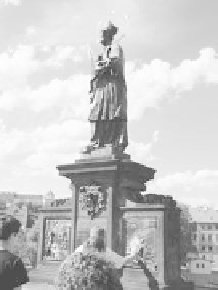Travel Reference
In-Depth Information
major flood in 1342, Emperor Charles IV decided to commission
an entirely new structure rather than repair the old one. Until the
19th century, this was Prague's only bridge that crossed the river.
Charles Bridge has long fueled a local love of legends—
including one tied to numbers. According to medieval record, the
bridge's foundation was laid in 1357. In the late 1800s, an amateur
astronomer noticed a curious combination of numbers, leading
to a popular theory about Charles IV. Charles is known to have
been interested in numerology and astrology, and was likely aware
of the significance of this date: the ninth of July at 5:31 in the
morning. Written out in digits—as the year, month, day, hour,
and minute—it's a numerical palindrome: 135797531. It's said
that Charles must have chosen that precise moment (which also
coincides with a favorable positioning of the earth and Saturn) to lay
the foundation stone of the bridge. Further “corroboration” of this
remarkable hypothesis was provided by the discovery that the end
of the bridge on the Old Town side aligns perfectly with the tomb
of St. Vitus (in the cathedral across the river) and the setting sun at
summer solstice. In the absence of accurate 14th-century records,
this intriguing proposition has delighted the modern Czech imagi-
nation. The number “135797531” is bound to remain celebrated as
the adopted birthday of Prague's most beloved structure.
The magically aligned spot on
the Old Town side is now occu-
pied by the
bridge tower,
con-
sidered one of the f finest Gothic
gates anywhere. Contemplate the
fine sculpture on the Old Town
side of the tower, showing the
14th-century hierarchy of kings,
bishops, and angels. Climbing the
tower rewards you with wonderful
views over the bridge (40 Kč, daily 10:00-19:00, as late as 22:00 in
summer).
In the 17th century, there were no
statues on the bridge—only a
cross,
which you can still see as part of the
third sculpture on the right. The
gilded Hebrew inscription celebrating
Christ was paid for by a fine imposed
on a Jew who mocked the cross.
T he bron z e Ba roque stat ue
depicting
John of Nepomuk
—a saint
of the Czech people—draws a crowd
(look for the guy with the five golden
stars around his head, near the Little




















